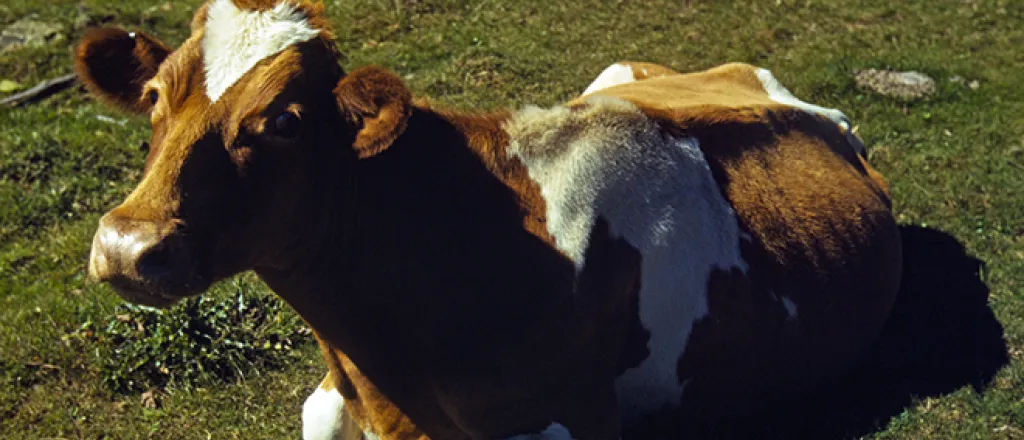
With cases of a strain of what is known as bird flu recently found in dairy cattle, USDA and other stakeholders have been busy monitoring the situation and implementing measures to protect our nation’s dairy cattle. Rod Bain looks at what has so far transpired in this edition of “Agriculture USA.”
PARTICIPANTS: Rod Bain and Secretary Tom Vilsack.
Transcript
(gentle music)
Since late March, several states have reported dairy cattle infected with the H5N1 strain of highly pathogenic avian influenza.
I think it's fair to say that we have been confronted with a novel circumstance with the H5N1 virus in dairy cattle, which has impacted and affected animal health, intersects with our food supply, and always in situations like this, involves the health and wellbeing of our farmers, their families, and farm workers, as well as public health.
That has prompted Agriculture Secretary Tom Vilsack at USDA, along with the Centers for Disease Control and Food and Drug Administration, to take preventative steps against this potential threat.
I'm Rod Bain.
Coming up, a look at efforts to curb an outbreak and gain further insight into virus prevention and spread in this edition of Agriculture USA.
The past few weeks have kept federal agencies involved in monitoring and prevention of an outbreak of highly pathogenic avian influenza, bird flu, busy.
But what makes this outbreak different is the cases of the H5N1 virus have been found not in birds, but in dairy cattle.
Over 30 cases in eight states by the time in late April that Agriculture Secretary Tom Vilsack talked with reporters about the situation.
Over the course of the last several weeks, we have been engaged in a coordinated and collaborative effort with sister agencies of the federal government, the Food and Drug Administration, the Center for Disease Control, and USDA.
We've also been coordinating and communicating with state and local officials in terms of animal health, agricultural officials, as well as public health officials.
What monitoring, testing, and preventative measures have so far indicated about H5N1, its threat to dairy cattle, and possible milk contamination includes the following.
Our testing to date shows pasteurization kills virus in milk.
CDC continues to monitor, but has seen no increase in foodborne illnesses.
The dairy cows that have gotten sick are recovering.
We will do additional testing and precautions for animals in interstate commerce.
There will likely be increased testing and surveillance as this situation evolves over time.
Some of the other findings discovered via USDA study and monitoring.
Over the last several weeks, USDA has noted spread between cows within the same herd, spread from cows to poultry, spread between dairies associated with cattle movements, and cows without clinical signs that have tested positive.
In fact, USDA has administered over 2,000 tests on samples taken from cattle over the course of the last several weeks, in addition to assisting FDA with its sampling of milk.
In addition, on April 16th, USDA's microbiologists did identify a shift in the H5N1 sample from a cow in Kansas that could indicate that the virus has had an adaptation to mammals.
CDC conducted further analysis of that specimen sequence, and their assessment is and remains a low risk overall.
Secretary Vilsack acknowledges the need for continued observation and data collection to better implement measures of prevention against the spread of the H5N1 high path AI virus in dairy cattle.
That is a primary reason behind a federal order issued by the Agriculture Department.
Among the components of the federal order, required mandatory testing for H5N1 for interstate movement of dairy cattle.
Prior to interstate movement, dairy cattle will be required to receive a negative test for influenza A virus at an approved National Animal Health Laboratory network laboratory.
Owners of herds in which dairy cows test positive for interstate movement will be required to provide information, including animal movement tracing.
And dairy cattle that does in fact move interstate will have to adhere to the conditions established by APHIS.
USDA's Animal and Plant Health Inspection Service, APHIS, provides oversight and guidance regarding mandatory testing.
We will focus primarily and specifically on lactating dairy cattle as we initiate this effort because this has been the area of the dairy industry that has been the focus of activity over the last several weeks.
While these requirements for other classes of dairy cattle will be based in the future on scientific factors concerning the virus and what its evolving risk profile might be.
We will indicate to producers that we intend to pay for and cover the cost of testing animals at our National Animal Health Laboratory network laboratory.
Mandatory reporting is also required for test results of cattle tested for H5N1.
The mandatory reporting really applies to all cattle.
The laboratories and state veterinarians are required to report any positive influenza A finding in livestock to USDA APHIS so that we are able to obtain information as quickly as possible.
The order is gonna require that lactating dairy cattle be tested and determined to be HPAI H5N1 free prior to interstate shipment.
And we expect that this sampling will provide necessary information that will allow us to better understand the scope of the outbreak since it was focused primarily on lactating cattle.
This has been Agriculture USA.
I'm Rod Bain reporting for the U.S. Department of Agriculture in Washington, D.C.







